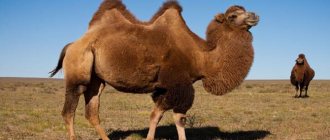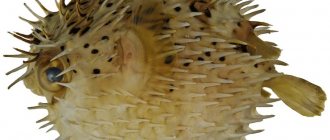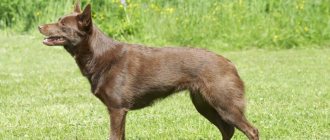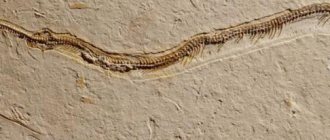Jumpers
belong to the family of African mammals and can be of different sizes; usually there are three types: large, medium and small.
Depending on the species it belongs to, the body size of a rodent can vary from 10 to 30 cm, while the length of the tail ranges from 8 to 25 cm. Jumper in the photo
It looks very cute and unusual, but in real life it is very difficult to see due to the fast speed of movement.
The muzzle of all jumpers is long, very mobile, and the ears of a rodent are the same. The limbs end in four or five fingers, the hind legs are much longer. The animal's fur is soft, long, the color depends on the species - from yellow to black.
This animal lives mainly on plains overgrown with bushes or thick grass, and is also found in forests. Due to their thick fur, jumpers do not tolerate heat well and that is why they look for shaded areas for a permanent place of life.
The forelimbs are designed so that the animal can easily dig hard soil. Sometimes this helps them create their own burrows, but most often the rodents occupy the empty houses of other steppe inhabitants.
Of course, jumpers can live not only in burrows; a reliable blockage of stones or dense branches and roots of trees are also suitable. The peculiarity of these rodents is their ability to move using all four or only two legs.
Thus, if an animal is a jumper
he is not in a hurry, he, moving all his paws, slowly moves along the ground “on foot.” However, in case of danger or when catching prey, when the rodent needs to quickly move from place to place, it rises only on its hind legs and quickly jumps. The tail, the length of which is often equal to the length of the body, is always raised up or trails along the ground behind the animal; the jumper never drags its tail behind itself.
It is extremely difficult to meet a jumper in its natural habitat, since the animal is very timid, and its mobile ears, sensitive to any sound vibrations, allow it to hear the approach of danger at a considerable distance. These rodents live in Zanzibar. In total, the jumping family includes four genera, which, in turn, are divided into fourteen species.
Appearance
Body length 95-104 mm and tail length 97-137 mm, weight 30-50 g. This is a small fluffy animal with a relatively large head, an elongated nose like a proboscis, and rounded ears. The hind legs are longer than the front ones and the animal’s movements resemble the jumping of a wind-up toy. The ears of this species are shorter and rounder than those of other members of the family. The first toe on the hind foot is small and has a claw. The color is sandy-brown in different shades, up to fawn in different parts of the range, the abdomen is whitish, and the tail is dark.
Morphological features
Animals of small and medium sizes. Body length from 10–12 to 30–31.5 cm, tail from 8 to 26.5 cm, weight from 40 to 540 grams. The coat is long, thick and soft. The color is uniform - from sand to brownish-black. There are also spotted species. The head is armed with a movable proboscis, hence the analogy between proboscis elephants and small shrews. Near the proboscis there are well-developed vibrissae. The sensitive proboscis is used by animals in search of food. The eyes are large, which is an uncharacteristic feature for insectivorous mammals, to which jumpers were previously classified. The ears are small. The length of the tail ranges from 80 to 120% of the animal's body length, and is thin and hairless. At the base of the tail there is a gland that secretes a secretion with which animals mark territory. The hind legs are longer than the front legs.
Four-toed jumper
The number of teeth is from 36 to 42 (in most species - 40). The skull is massive, with well-developed zygomatic arches and an extensive braincase. The brain is well developed, a result of developed sensory organs and complex behavior. The number of vertebrae is as follows:
- cervical - 7,
- chest - 13,
- lumbar - 7–8,
- sacral - 3,
- tail - 25–28.
There are two or three pairs of nipples. The appendix is well developed, unlike insectivorous mammals.
Somali jumper
Diet and feeding behavior
Jumpers feed primarily on insects, mainly ants and termites, and also eat shoots, roots and berries. The feeding behavior of a female elephant jumper in the desert is described: the animal basked in the last rays of the sun in the evening, then yawned, stretched and ran to the feeding area, where it ate ants (they were active at that time). During breaks, he cleaned himself and checked shelters. So the jumper could spend the whole night in the feeding area.
Distribution and habitats
Both fossil and modern species are found only in Africa. They are found primarily in sub-Saharan Africa, with only one species (the North African jumper) found in Algeria and Morocco. They do not live in West Africa, but inhabit the island of Zanzibar. They are found in almost all types of landscapes - from the Namib Desert to tropical forests. Species of the genera long-eared (Elephantulus) and short-eared jumpers (Macroscelides) prefer to settle in savannas and deserts, and species of the other two genera prefer to live in forest areas.
Common elephant (short-eared) jumper
Reproduction
Both courtship and mating take place within the female's territory, usually within the same night and day. If the female is ready to mate, then mating occurs quickly. In nature, pregnant females were observed in August and September. Thus, reproduction is confined to the warm and humid period of the year. The species is polycyclic. In one season in nature, a female can have up to 3 litters. Pregnancy lasts 56-60 days. There are 1-2 cubs in a litter. Newborn elephant jumpers are well developed, their eyes are open, they are covered with fur and can move around. They leave their shelter at the age of 18-36 days, at which time they are already eating solid food well. At 46 days they reach the weight of adult animals, and at 7-8 months they become adults.
Lifestyle
Exclusively terrestrial animals, very mobile. They usually move on all fours, but when in danger, like jerboas and kangaroos, they begin to jump energetically, like a spring. They are active mainly during the day, some even at dusk. When it is very warm, they switch to a nocturnal lifestyle. During the day they hide under stones, rhizomes, bushes or in small holes. They live alone or form monogamous pairs that actively defend the territory. The exception is some species that form small colonies. As a rule, they do not make sounds, only in case of danger they knock their legs or tail on the ground.
North African jumper
Elephant Jumper - how to make a mouse out of an elephant
Very simple! In any case, from the point of view of nature, there is nothing complicated in this process. See for yourself: we take an elephant and reduce it to the size of a mouse, it’s elementary, don’t you agree? Most likely, this is how elephant jumpers were born.
In any case, scientists have been twisting them in different ways for many years, trying them on this way and that way. Jumpers were also classified as lagomorphs, insectivores, and shrews.
Capricious "star"
And we finally settled on the fact that elephant jumpers belong to the superorder Afrotheria, which, in addition to many other, not properly classified living creatures, includes, don’t laugh, elephants! They, the jumpers, are even kept in zoos next to these thick-skinned giants.
What is an elephant jumper? This is a very small, up to 10 centimeters long and weighing up to 50 grams, shaggy misunderstanding on matchstick legs with curious eyes and a long thin tail. The ears are round, like those of the Cheburashka, but much smaller. This miracle lives only in Africa and has no plans to move from there unless zoo owners urgently want to see it.
But when moving, the jumper, like a capricious “star”, requires special treatment: a well-controlled room temperature and exceptionally fresh, or rather even live insects for breakfast, lunch and dinner, fruits, also fresh, cottage cheese. But mostly preference is given to ants and termites.
By the way, it is precisely for this reason, and for many other reasons, that it is highly not recommended to keep an elephant jumper at home. This is not a domestic animal, and it’s not easy with him in the zoo. But this is true, by the way.
Why "elephant"?
The animal’s nose is quite elongated and resembles a trunk, for which the jumper was called elephantine. And why, exactly, the jumper? Everything is very simple here. This is a local name, coined by the Aborigines long before the appearance of pale-faced zoologists. The fact is that the animal’s hind legs are much longer than its front ones, and when it is in danger, it stands on these legs and easily jumps away, like a miniature kangaroo.
And if the sky is clear and there are no enemies nearby, then the jumper does not waste his energy and walks calmly on all four legs. Of course, the jumper is not healthy enough to jump far, and he is not the same size. But he usually manages to gallop to the hole in which he can wait out adversity. Moreover, jumpers never go far from their holes, who knows?
Making a jumper jump is not so easy. To do this, you need to scare him well, then things will work out. By the way, if you frighten an animal very much (for example, suddenly pick it up, wild and untamed, in your arms), then it will also make a voice – it will start squeaking. Although usually in life the jumper is completely taciturn.
Independence from birth
The animal is a mammal, but does not sit on its parent’s neck for a long time, and is born almost independent: in its own fur and practically with open eyes. After being fed by his mother for three weeks (who didn’t even build a nest for the sake of his birth), and without seeing his father (who even before his birth went somewhere and never returned), the jumper goes free. He chooses or digs a hole for himself and lives in it as a bob until the end of time.
Jumpers form married couples only for a short-term need, after which they quickly scatter and no longer need each other and generally do not need a team. Although sometimes you can find animals in nature living for quite a long time in twos or threes, this is a rarity, which is usually explained by difficult conditions: a small area for living, land in which you can barely dig one or two holes, little food and a lot of other things. more. That is, the jumpers live nearby, almost in the same hole. But they live as if in a communal apartment, not paying special attention to each other, out of necessity, so to speak.
The life of elephant jumpers is simple and sinless. Day is the time of highest activity. You need to catch and eat ants, move from bush to bush for some of your needs, and at midday you need to stand on your outstretched hind legs and bask in the sun. By evening, you need to have a couple more snacks and, finally, climb into a hole away from nocturnal predators.
Life in the zoo for an animal follows almost the same schedule. By the way, the elephant jumper first appeared at the Moscow Zoo only in 1991, arriving from South Africa. As far as we know, jumpers are kept in zoos in Minsk, Riga, Grodno and Berlin.
Konstantin Fedorov
A little background on the short-eared jumper
The history of studying this species is somewhat reminiscent of an anecdote. Just not everyday-situational, but scientific.
When this animal was discovered in the south of the African continent, biologists immediately tried to determine who it was, which was a completely natural desire. But who does he look like? In general, no one except other similar jumpers. At first, the short-eared jumper was assigned to the order of insectivores, considering that they were close relatives of hedgehogs, shrews and moles. However, after some time, scientists, having carefully looked at this mammal, “came to their senses” and, looking closely at some features of the internal organization of the short-eared jumper, decided that most of all, no matter how wild it sounds, it resembles a primate! Following this, a proposal was made to declare jumpers as primitive representatives of the order of primates.
Paleontologists did not stand aside and expressed the idea that jumpers are not primates for the simple reason that they are close relatives of ancient ungulates. So, in a very short period of time, the jumper managed to be a relative of hedgehogs, monkeys and horses. Apparently, the scientific world did not like such uncertainty, and scientists holding different views decided to separate these funny animals into a separate order belonging only to them, which was given the Latin name Macroscelidae.
Nutrition
All elephant shrews feed primarily on invertebrates such as insects, spiders, centipedes and earthworms. When searching for food, they mainly use their sense of smell. As soon as they find prey, they use their tongue. In structure and function it is very similar to the tongue of anteaters. Some species also consume plant foods such as leaves, seeds and small fruits, and also eat other small mammals and bird eggs. Some species obtain moisture from the food they eat and drink almost no water.
Peters's proboscis blenny
Lifestyle of the short-eared jumper
Short-eared jumpers inhabit the semi-deserts and savannas of the southwestern part of South Africa, living in countries such as South Africa, Southern Botswana and Namibia. The total distribution area of the short-eared jumper is more than half a million square kilometers.
Short-eared jumpers lead a predominantly diurnal lifestyle and are active even during the hottest hours of the day. Moreover, at this time these animals love to take dust baths or bask in the sun. The short-eared jumper can change its daily activity regime and search for food in the twilight only when threatened by its natural enemies, among which the main ones are various birds of prey. In this case, being active in the twilight, the short-eared jumper will hide in the vegetation during the daytime. As a refuge, they usually choose empty burrows left behind by other rodents.
However, you should not think that the short-eared jumper is only capable of living in other people’s homes. If a suitable vacant apartment is not found, then he can dig a hole on his own. In any case, they do it very well in sandy soil. They also like to dig burrows near bushes, especially at their roots.
As a rule, short-eared jumpers lead a solitary lifestyle and, living in natural conditions, prefer to stay alone. And only during the mating season they unite in pairs. The total territory occupied by the jumper is usually one square kilometer.
Population status of the short-eared jumper
In 1996, short-eared jumpers were included in the so-called Red List of the International Union for Conservation of Nature, receiving the status of “vulnerable species”. But seven years later, this decision was revised, and the status of the jumper was determined as “not endangered.” This revision of the decision is explained by the fact that, despite the fact that the population density of these animals is very small, the territories occupied by this species are very large.
If you find an error, please select a piece of text and press Ctrl+Enter
.











